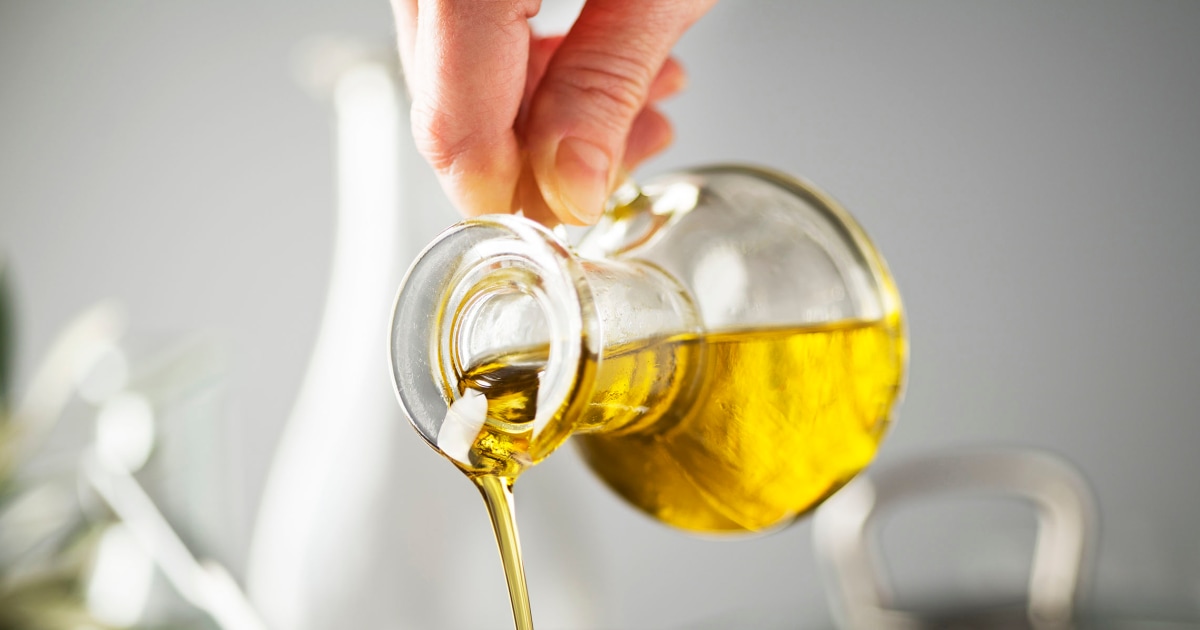Cooking oil is a kitchen staple that’s important for both culinary and health purposes. Using oil helps food heat evenly, reduce sticking and enhance flavor and texture. Oil also provides us with fats, an essential macronutrient the body needs for energy, insulation, vitamin absorption, and more.
However, not all oils are equal, and there are plenty of different cooking oils to choose from. At the grocery store, you may be overwhelmed with the seemingly endless options. These oils come from various vegetables, seeds, and nuts. Some are labeled organic, virgin or refined, and the price varies widely.
Are the cheaper oils in plastic gallon jugs just as good as the expensive specialty oils in fancy bottles?
Maybe you’re curious about seed oils, which have been vilified for being unhealthy. Popular plant-based oils such as canola and soybean oil often get a bad rap despite their high unsaturated fat content, which has many research-backed benefits.
The misconception that seed oils can cause health problems is due to their high levels of omega-6 fatty acids, which the body needs but may promote inflammation when a person’s diet is too low in omega-3 fatty acids. The typical American diet has a higher ratio of omega-6s to omega-3s, TODAY.com previously reported.
A recent study found a link between eating too many processed foods — which are often high in seed oils — and colon cancer. However, the results did not show that cooking oils, including seed oils, cause cancer, the study author told TODAY.com. As the case with many foods, seed oils are safe and healthy in moderation.
However, it still begs the question, which cooking oils are the healthiest?
Where oil comes from and how it’s processed can impact the nutrition content and benefits. What’s more, the cooking temperature can also impact oil’s nutrition profile. TODAY.com spoke to dietitians about the healthiest cooking oils, which ones to limit or avoid, and how to choose the right oil for your needs.
Is cooking with oil healthy?
“Cooking oil can definitely be part of a healthy diet,” says Natalie Rizzo, registered dietitian and nutrition editor for TODAY.com.
Oils are essentially pure fat, but fat is good for you. Fats are needed for cell function and help the body store energy, use nutrients, and produce hormones, TODAY.com previously reported. They support heart, brain, and gut health.
Cooking oils also provide fat-soluble vitamins and antioxidants — not to mention, they make cooking easier and food taste a lot better.
However, you should aim to consume more “good” or healthy fats (polyunsaturated and monounsaturated fats) and fewer “bad” fats (saturated and trans fats), per the AHA.
Moderation is also key. “The serving size for oil is small: one tablespoon. Having more than that can drastically increase your calorie and fat intake above the recommended amount,” says Rizzo.
It’s important to note that consuming any fat, good or bad, means additional calories, Beth Czerwony, registered dietitian with the Cleveland Clinic’s Center for Human Nutrition, tells TODAY.com. All fat provides 9 calories per gram. “That needs to be considered when evaluating your diet overall,” Czerwony adds.
The World Health Organization recommends adults limit their total fat intake to 30% of their daily calories or less. If you’re unsure how many grams of fat you should be eating per day, talk to your doctor.
Choosing healthier cooking oil
When selecting a cooking oil, it’s important to read the nutrition labels and look for a few key things, the experts say.
Saturated fat
Healthier cooking oils are low in saturated fat, the experts say. The lower, the better. “The American Heart Association recommends choosing oils with less than four grams of saturated fats per one tablespoon (or serving),” says Czerwony.
Cooking oils that are high in saturated fats may have negative health effects if used in excess, says Czerwony. Saturated fat can raise “bad” cholesterol or LDL, which can clog arteries. Consuming high amounts of saturated fat, over time, increases the risk of heart disease and stroke, according to the AHA.
Fortunately, most cooking oils also contain unsaturated fats (mono- or polyunsaturated), Rizzo adds. Healthy fats can help boost HDL, or good cholesterol, lower LDL, and stabilize blood glucose, TODAY.com previously reported. Unsaturated fats are also beneficial for heart and brain health, says Rizzo.
Oils high in unsaturated fats are liquid at room temperature, whereas those high in saturated fats are solid. “A good way to know if it’s saturated fat is to remember, solid at room temperature equals solid in your arteries,” says Czerwony.
Other types of solid fats include animal fats — such as butter, lard or tallow — which are high in saturated fat and can raise bad cholesterol, per the AHA.
Trans fats are often formed through a process which uses hydrogen to turn liquid oil into solid fat, such as margarine and shortening, per the National Institutes of Health. These should be avoided due to the health risks, the experts note.
Non-tropical plant sources
The source of oil can also affect the nutrition. “There are oils from fruits, such as olives and avocados. There are also oils that come from seeds, like canola oil, sunflower seed oil and grapeseed oil. Lastly, there are nut oils, like walnut or peanut oil,” says Rizzo.
Healthier cooking oils tend to be from non-tropical plants, the experts say. These include vegetables, fruits, nuts, and seeds grown in cooler, temperate climates.
“Tropical oils” from plants grown in tropical regions — including coconut, palm and palm kernel oil — are much higher in saturated fat than non-tropical liquid oils, says Czerwony. Saturated fat-rich tropical oils are also solid at room temperature, she adds.
Refined vs. unrefined
The way cooking oil is made also affects the nutrition. First, the oil is extracted, either mechanically (such as cold-pressing) or chemically using solvents to separate the oil.
Then, many cooking oils are refined to remove impurities and make them more heat- and shelf-stable, Czerwony notes.
Refined oils have a more neutral flavor and withstand higher temperatures, making them a versatile and practical option for cooking. They also tend to be cheaper, the experts note.
However, the refining process also removes some beneficial nutrients, the experts note. “Look for unrefined oils if possible, which will still have more nutrients and antioxidants that are often lost in the refining process,” says Czerwony.
Unrefined oils may be cloudy, contain sediment, and have a more robust flavor. They tend to be more expensive and have a shorter shelf life, says Czerwony, but the health and gastronomic benefits are usually worth it.
Bottom line: When choosing a healthier cooking oil, experts recommend looking for ones that are:
- Low in saturated fat (less than four grams per serving)
- Non-tropical
- Unrefined
Which oil is best for heating?
When it comes to the nutrition of cooking oil, it’s important to consider how you’ll use the oil and the smoke point, says Czerwony.
The smoke point is the temperature at which oil starts to degrade and burn, which is usually between 325 degrees to 450 degrees Fahrenheit, per the U.S. Department of Agriculture.
“Heating oil breaks down the composition of the oil, which can change the flavor and nutrition,” says Rizzo. Oil can oxidize when it’s exposed to too much heat (or light) and become rancid.
Heating oil beyond its smoke point can destroy nutrients and produce free radicals, which can damage cells, Czerwony explains.
“The antioxidants and fat levels in the oil determine how quickly it will oxidize,” Rizzo adds.
Some oils are better suited for high-heat cooking, such as frying, because they can withstand higher temperatures without smoking or burning, says Czerwony. Oils with a higher smoke point include avocado, canola, and peanut oil.
Other oils are best for cooking with medium heat, such as baking or sautéing. These include olive and vegetable oils.
Cooking oils with a low smoke point should not be heated. “These are (best) for salad dressings or as a flavor enhancement to finish a dish,” says Czerwony. These include walnut, flaxseed, and wheat germ oil.
Always read the labels, which often indicate the smoke point or intended cooking methods.
What is the healthiest cooking oil?
Olive oil
Olive oil is considered the healthiest oil for everyday cooking due to its nutrients and well-researched benefits.
A one-tablespoon serving of olive oil contains about 119 calories and 13.5 grams of fat, according to the USDA. Most of these are healthy fats, including monounsaturated fatty acids. Olive oil is about 75% monounsaturated fat, which means it has the highest amount of any plant oil, per the AHA.
Olive oil is rich in vitamin E, which helps protect the body from oxidative stress, and antioxidants, including polyphenols, which have been shown to decrease inflammation and improve heart health, says Czerwony. “Including olive oil in the diet has been linked to reductions in heart disease, diabetes and other chronic diseases,” Rizzo adds.
The experts recommend opting for “extra virgin olive oil” or EVOO, as this is the least processed and typically has more nutrients.
Olive oil can withstand temperatures up to 410 degrees Fahrenheit, per the USDA, so you can use it to roast, sauté, bake and more. Extra virgin olive oil also has the lowest oxidation rate of any oil, per the Cleveland Clinic, which means it’s more stable and less prone to emitting free radicals when heating.
Other healthy cooking oils
There are a number of other plant oils which provide unsaturated fats, vitamins, and antioxidants, making them a smart choice. When choosing an oil, always consider any food allergies or sensitivities.
These cooking oils can all be part of a healthy diet when consumed in moderation:
- Avocado oil
- Canola oil
- Peanut oil
- Safflower oil
- Sesame oil
- Grapeseed oil
- Sunflower oil
“Vegetable oil” may be made from one or a blend of these oils.
It may be best to have a few healthy cooking oil options to use for different types of cooking, the experts note.
What is the least healthy cooking oil?
The least healthy cooking oils are high in saturated or trans fats. These include coconut oil, palm oil, and partially hydrogenated oils.
Coconut oil is 80-90% saturated fat, says Rizzo, compared to other oils which are typically 10–20% saturated fat. “The AHA discourages using coconut oil since the saturated fat can raise LDL cholesterol,” says Rizzo.
Coconut oil may have benefits for skin and hair, but eating a lot of it may increase the risk of health issues.
“Coconut oil has not had any large-scale research to support any health benefits and it far exceeds four grams saturated fats per tablespoon, making it higher in fat than butter,” says Czerwony.
If you can’t avoid coconut oil, try to limit your intake and only use small amounts for cooking, says Rizzo. Palm and palm kernel oils are also high in saturated fats and should be avoided when possible, says Czerwony.
Tips for using storing and cooking with oil
Common mistakes can compromise the oil’s quality and taste, says Czerwony. Use these tips to store and use cooking oil properly:
- Store oil in a dark, cool place to avoid oxidation
- Use oil within several months of opening
- Do not refrigerate cooking oils
- Discard expired cooking oil
- Do not reuse cooking oil
- Discard oil after it smokes or catches fire


